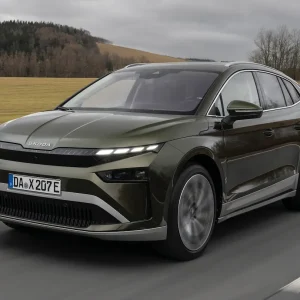‘Game-changer’ is an overused phrase – especially by some automotive marketing departments when referring to product that’s hardly groundbreaking – but Tesla really has been, so far.
It has only launched four models worldwide since it was founded in 2003: the Lotus-based Roadster in 2008, followed by the models S, X and 3. However, Tesla’s full-electric-only powertrains, less-is-more cabins designed around a huge central infotainment screen, plus new ways of manufacturing, selling and charging have genuinely shaken up existing carmakers’ ways of thinking and doing.

The Model X – an all-electric, large SUV that’s more than 5m long – is Tesla’s most practical car to date and available in five, six or seven-seat variation. It’s big and dramatic in many other ways beyond its length. ‘Falcon-winged’ doors create an entrance like no other and allow great access to the rear seats, while sensing and avoiding low ceilings and nearby car doors. The X’s massive windscreen extends high above the front seats to flood its spacious cabin with light. Its wide-and-tall 17in portrait-shaped touchscreen with excellent Google Maps traffic updates, among many other functions, makes for a compelling and connected experience.
The regular boot area is an exception to this ‘large’ rule. In six-seat mode, the space behind the third row is only 357 litres. But fold the third row and that figure expands to 1,410 litres. Pushing forward and pitching the second row raises it again to 2,002 litres (there’s another 187 litres in the ‘front boot’ for a weekend bag).
Acceleration is rapid and linear, and the ride and handling is benign, if not quite exhilarating in the same way as a performance petrol SUV from BMW, Porsche or Jaguar.

The official 351-mile range is impressive, though, and makes non-stop, intercity electric car travel a possibility in a way that other current EVs can only dream of. In reality, routes still need to be planned with care. Tesla’s Superchargers are quick – 150 miles in 45 minutes was our reality on a cold day – but the current network is too small for adequate UK coverage, with locations counted in the dozens, not hundreds.
The enticing 4.7-seconds to 62mph performance soon saps range as well. A case in point: my 115-mile trip from south London to east Bristol, going to and from houses without 13.5kWh Tesla home-charging points. Upon departure, 270 miles showed on the driver display, but I only had 68 miles left to play with the following morning. The nearest public Tesla chargers were both hogged by Model S cars and the next nearest options were nine miles in the wrong direction to my way home. Throw in an M4 closed for roadworks that weekend – which nixed the Reading Supercharger option and necessitated a lengthy diversion via the M3 – and major range anxiety ensued, not to mention extra travelling time.

Of course, when you’re spending nearly £100,000 on an electric vehicle, you’ll probably have access to off-street parking and will have already bought the Tesla Wall Connector which costs £460-£1000 (depending on your install) – so it would matter less.
Tesla’s public network is expanding, too. For those with the upfront funds, the resulting savings stack up in BIK (13%) and ‘fuel’ costs (nil to low) versus petrol SUVs with similar performance and power, including the Range Rover Sport and Porsche Cayenne (both 37% BIK and early 20s mpg). That’s before even the eco credentials are considered.
Meanwhile, everyday business drivers will have to hope Tesla can get its manufacturing problems for the BMW 3 Series-rivalling Model 3 sorted before something similar, but more affordable, becomes available. Then the game really will have been changed.
Tesla Model X 100D
P11D £92,550*
On sale Now
Range 351 miles
CO2(BIK band) 0g/km (13%)
BIK 20/40% a month £201/£401
Boot space 357 / 2,189 litres**
Power 619hp 100kWh motor
*Six-seat option is £5,700 extra
**including 187-litre front boot





